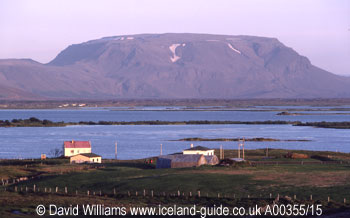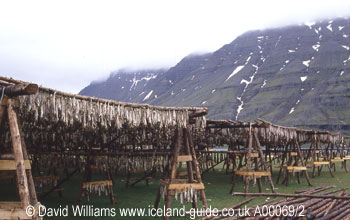 |
| The
lake of Mývatn with the mountain Bláfell behind. A couple
of generations ago much of Iceland`s population lived in farms such
as these but every year more and more older people leave the farms
to live in the towns, especially Reykjavík. |
 |
| These
racks near the eastern fishing town of Seyðisfjörður
carry thousands of stockfish (wind-dried cod). Fishing is the mainstay
of the Icelandic economy and its most important export. |
Two similar
apartment blocks (each with thirty-five flats) had a central communal
area and this was shared by the residents of other nearby blocks. A cafeteria,
lounge, rooms where people could do handcrafts, a hairdresser, massage
room and numerous other facilities were at hand. All of this was finished
in typical modern Icelandic style — very comfortable without being
fussy or flamboyant (polished wood and light colours are very popular).
The buildings are kept wonderfully warm by geothermally-heated hot water
so even though Reykjavík is close to the Arctic Circle, no-one
need shiver while indoors during the winter months (outdoors is another
matter altogether!). Such excellent facilities are quite common in Iceland
and are provided free by the local authorities. Care of the elderly is
an important issue in the country, especially when the winters are long
and dark and many people, especially the elderly, are forced to stay indoors
for long periods of time. The elderly (and those preparing for retirement)
have a fair amount of political clout and this ensures that politicians
are attentive to their needs.
We sat in the cafeteria and chatted over coffee with Peter; the centre
has a travel bureau and he was going on one of their day-trips to Greenland
that afternoon — Icelanders don`t stay still for long during the
summer! Many of the flats` residents went on bus tours and took advantage
of the summer`s long hours of daylight to visit the countryside. Bragi
was going to the western peninsula of Snæfellsnes in the
next few days, on one of his twice-yearly fishing trips.
Both Bragi and his wife are seventy-five years old and live off their
state pension and Bragi`s company pension. The retirement age for both
sexes is sixty-seven and there has been a state pension since 1947. At
present this amounts to a flat rate of IKr11,000 (100IKr = about £1)
per month and a variable sum (up to a maximum of IKr20,000 per month)
based on income (the lower the income, the higher the pension). The cost
of living in Iceland is high, especially since many consumer goods and
foods have to be imported, and pensioners often have to rely on savings
or staying with relatives in order to maintain a good standard of living.
Although living conditions can be very hard, it is noteworthy that the
Icelanders` longevity is second only to Japan, with men living to an average
age of seventy-four years and women to eighty-one years of age (1980 figures).
Interestingly, the diets of both these countries (and of the Faroes, another
country high in the longevity tables) have a very high fish content.
This longevity means that the social services` provisions can be hard
pressed to cope with the numbers of people who require assistance. In
1984 some 24,000 people were aged sixty-five years old or over; this was
10% of the population and this number is expected to rise dramatically
over the next decade or so. With an economy that is at the mercy of the
fluctuations in world fish prices, this is a social and economic problem
that the country is having to face up to.
Back
to the list of articles about this country
|

